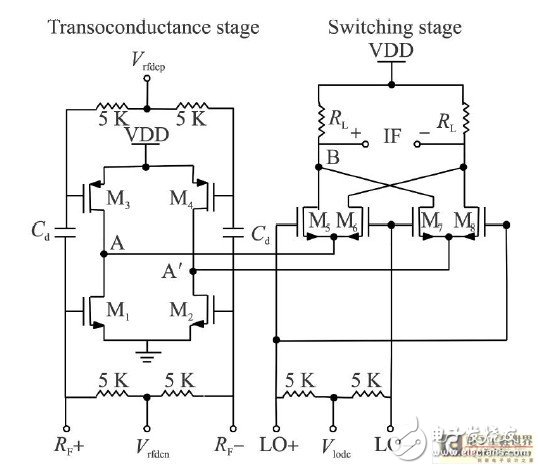Currently, wireless communication devices are trending toward lower voltage, reduced power consumption, minimized noise, and improved linearity. As a critical component in transceivers, the mixer significantly influences these performance metrics. With advancements in microelectronics, the gate length of CMOS devices has been reduced, leading to smaller overdrive voltages. This makes it feasible to design low-voltage and low-power RF circuits, although it also imposes limitations on further lowering the operating voltage. As a result, researchers have increasingly focused on circuit topologies, making low-voltage RF circuits a prominent area of study. The traditional Gilbert mixer consists of three stages: a transconductance stage, a switching stage, and a load stage stacked vertically. In this configuration, all DC current flows through each stage. Both the transconductance and switching stages require a certain turn-on voltage (Von), while the load stage introduces a voltage drop (VRL). Consequently, the minimum supply voltage is Vdd,min = 2Von + VRL. If a low supply voltage is used, it may not be sufficient to keep all transistors in saturation, limiting the mixer’s ability to operate under low-voltage conditions. To address this, some studies, such as references [2–3], propose removing the tail current source to reduce the supply voltage. Others, like [4–11], use folded structures instead of stacked ones to solve this issue. Reference [8] compares the folded structure with the stacked one. The folded structure includes two RF interrupt circuits and a coupling capacitor, which separate the transconductance stage from the DC paths of the switching and load stages. This allows for independent operation between the two branches, reducing the required supply voltage to Vdd,min = Von + VRL. However, RF interrupt circuits often rely on LC resonant networks, which increase layout area and introduce more noise. In this paper, we present a new folded mixer that eliminates the need for large inductors. Operating at 1.2 V, the circuit achieves low voltage, low power, low noise, and high linearity. The folded mixer topology proposed in this paper is illustrated in Figure 1. M1 to M4 form the transconductance stage, M5 to M8 are the switching stage, and RL represents the load resistance. The RF input is connected to a matching network, while the IF output is connected to a source follower as an output buffer. Figure 1: AC-coupled folding mixer topology The transconductance stage of the folded mixer employs current multiplexing technology. It uses NMOS transistors (M1, M2) and PMOS transistors (M3, M4) along with a DC blocking capacitor Cd to create an AC-coupled complementary transconductance structure. The output of the transconductance stage (points A and A’) is connected to the source of the switching transistors. Since the transconductance stage is directly connected to the power supply, the DC current splits into two parts: one through the switching transistor and load resistor, and another through M3 and M4. This design effectively reduces the required supply voltage. Due to the small current through the switching and load stages, the flicker noise generated by the switching transistors is reduced, and the load resistance can be increased to improve conversion gain. Thus, the circuit meets low-voltage requirements while maintaining good performance under low supply voltage conditions. Figure 2 shows several transconductance circuits for folded mixers. In Figure 2(a), the drain of the NMOS transistor M1 is connected to a load resistor R. The current In of M1 splits at point A, with part flowing through the switch tube (Is) and the rest through the load resistor (IR). However, this configuration causes some RF signal leakage to the AC ground through the load resistor R. To minimize RF signal loss, the load resistor R must be increased, which lowers the DC voltage at node A. Under low supply voltage conditions, this may prevent M1 from operating in saturation. To resolve this, the load resistor R is replaced with an active load, as shown in Figure 2(b). However, the PMOS transistor here only increases the impedance between node A and the power supply. By connecting the gates of M1 and M2 to form a CMOS inverter structure, M2 can increase the impedance and amplify the RF signal, as shown in Figure 2(c), thus preventing RF signal leakage through M2 to the AC ground. As seen in the figure, Is = In + Ip, and the total transconductance is gm = gm_n + gm_p (where gm_n is the transconductance of the NMOS transistor and gm_p is that of the PMOS transistor). Therefore, the CMOS inverter effectively enhances the mixer’s conversion gain. Analyzing the DC operating condition of the structure, the gates of M1 and M2 are biased with the same voltage Vrfdc. Assuming Vt is the threshold voltage of the MOS transistor, Vovn is the overdrive voltage of M1, and Vovp is that of M2. Then, Vovn = Vrfdc - Vt and Vovp = Vdd - Vrfdc - Vt. Hence, the minimum supply voltage is Vdd,min = Vovn + Vovp + 2Vt. Box Mod can also be described as bettery mod which always contain a ignition button, a display screen, battery cover, 510/810pin, etc. Some box mod even have chipset to control power or temperature or something. Such like Geekvape, Lost Vape, Wismec are good at producing well-built box mods Main products:Disposable Vape,Disposable Vape Pen,CBD VAPE PEN ,PUFF BAR,E CIGARETTES,Vape Pen,Mini E-Cigarette,Cbd Cartridge,Cbd Battery,CBD Disposable Vape Pen,E Cigarette.Box Mod KIT,E-Cigarette Cartridges,POSH PLUS XL,Mr fog max ect. box kit sets,box mod kit,box mod starter kit.vape box mod starter kit Shenzhen Ousida Technology Co., Ltd , https://en.osdvape.com